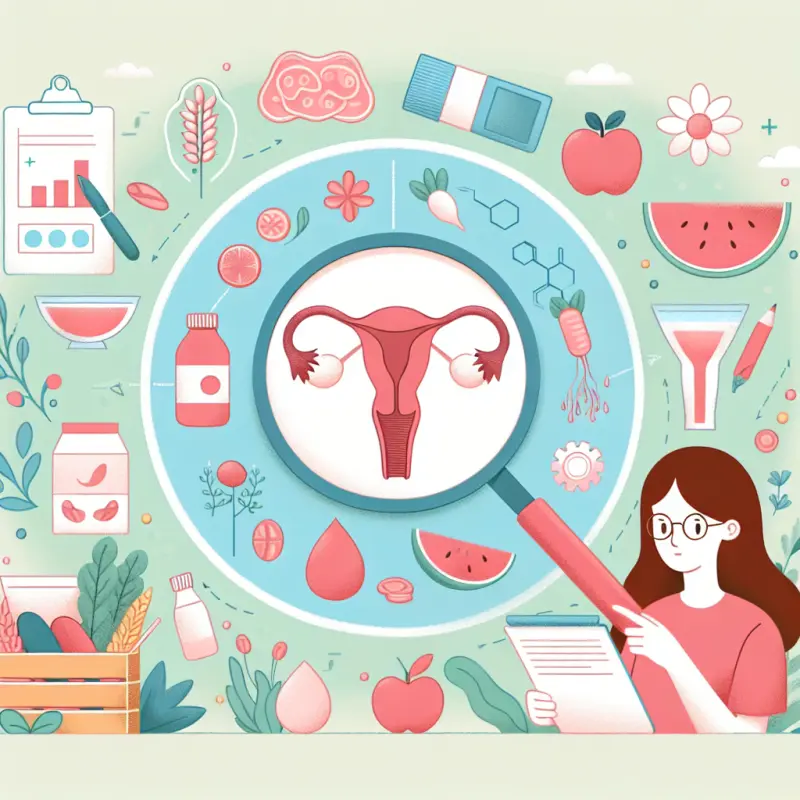How Nutrition Affects Your Menstrual Cycle: The Science Explained

How Nutrition Affects Your Menstrual Cycle: The Science Explained
Introduction
The menstrual cycle is a natural and complex process that involves a series of hormonal changes. These changes prepare the body for potential pregnancy and manifest in different phases over approximately 28 days. Factors such as stress, lifestyle, and notably, nutrition can significantly affect the menstrual cycle's regularity, symptoms, and overall health. Understanding the connection between nutrition and the menstrual cycle can empower individuals to make informed dietary choices that support their reproductive health.
In this article, we will explore how various nutrients influence the menstrual cycle, the impact of specific dietary patterns, and practical dietary recommendations to promote a healthy menstrual cycle. We will delve into the science of nutrition and its effects on hormonal balance, cycle regularity, and menstrual symptoms such as premenstrual syndrome (PMS).
The Basics of the Menstrual Cycle
Before delving into nutrition's role, it's essential to understand the menstrual cycle's basic phases and hormonal dynamics:
-
Menstrual Phase: The cycle begins with menstruation, where the uterine lining sheds. This phase typically lasts 3-7 days.
-
Follicular Phase: Following menstruation, the follicular phase begins, lasting around 13-14 days. During this phase, the pituitary gland releases follicle-stimulating hormone (FSH), stimulating ovarian follicles to mature. Estrogen levels rise, thickening the uterine lining.
-
Ovulation: Triggered by a surge in luteinizing hormone (LH), ovulation occurs around day 14 in a 28-day cycle. A mature egg is released from the ovary.
-
Luteal Phase: Post-ovulation, the luteal phase lasts about 14 days. The ruptured follicle transforms into the corpus luteum, producing progesterone to maintain the uterine lining. If fertilization doesn't occur, hormone levels drop, leading to menstruation.
Understanding these phases helps contextualize how nutrition impacts each stage of the cycle.
How Nutrition Influences the Menstrual Cycle
1. Macronutrients and Their Role
Carbohydrates
- Energy Supply: Carbohydrates are a primary energy source, necessary for maintaining stable energy levels throughout the cycle. Low carbohydrate intake can lead to fatigue and irritability, particularly premenstrually.
- Blood Sugar Regulation: Complex carbohydrates help stabilize blood sugar levels, mitigating mood swings and cravings often associated with PMS.
Proteins
- Hormone Production: Proteins are vital for hormone synthesis, including those regulating the menstrual cycle.
- Tissue Repair and Growth: Adequate protein intake supports tissue health and repair during menstruation.
Fats
- Hormonal Balance: Healthy fats, particularly omega-3 fatty acids, play a crucial role in hormone production and balance.
- Inflammation Reduction: Omega-3s have anti-inflammatory properties, potentially alleviating menstrual pain and discomfort.
2. Micronutrients and Menstrual Health
Iron
- Blood Loss Replenishment: Menstruation results in blood loss, necessitating adequate iron to prevent anemia and fatigue.
- Sources: Red meat, poultry, fish, lentils, and fortified cereals.
Calcium and Vitamin D
- Bone Health: Essential for bone health, particularly important for women with heavy menstrual bleeding.
- PMS Symptom Relief: Calcium and Vitamin D may alleviate PMS symptoms, including mood swings and cramps.
Magnesium
- Muscle Relaxation: Magnesium helps relax muscles, reducing menstrual cramps.
- Mood Regulation: Supports serotonin production, potentially easing mood swings.
B Vitamins
- Energy Production: B vitamins are crucial for energy metabolism, helping combat fatigue.
- Hormonal Regulation: Vitamin B6, in particular, supports neurotransmitter synthesis, influencing mood and PMS symptoms.
3. Dietary Patterns and Their Impact
The Western Diet
- High in Processed Foods: Often high in sugar, unhealthy fats, and refined carbohydrates, which can exacerbate PMS symptoms and hormonal imbalances.
- Low in Nutrient-Dense Foods: May lack essential vitamins and minerals necessary for menstrual health.
The Mediterranean Diet
- Rich in Whole Foods: Emphasizes fruits, vegetables, whole grains, lean proteins, and healthy fats, supporting overall health and hormonal balance.
- Anti-inflammatory Properties: The diet's focus on omega-3s and antioxidants may decrease menstrual pain and improve cycle regularity.
Plant-Based Diets
- High in Fiber: Supports digestive health and estrogen metabolism, potentially improving cycle regularity.
- Potential Nutrient Deficiencies: Requires careful planning to ensure sufficient intake of iron, vitamin B12, and omega-3 fatty acids.
Practical Dietary Recommendations for a Healthy Menstrual Cycle
1. Maintain a Balanced Diet
- Diverse Food Intake: Incorporate a variety of foods to ensure a comprehensive nutrient intake.
- Prioritize Whole Foods: Focus on whole grains, lean proteins, fruits, vegetables, and healthy fats.
2. Focus on Anti-inflammatory Foods
- Incorporate Omega-3 Rich Foods: Include fatty fish, flaxseeds, and walnuts.
- Consume Antioxidant-Rich Foods: Berries, leafy greens, and nuts can reduce inflammation.
3. Monitor Micronutrient Intake
- Iron and Vitamin C: Pair iron-rich foods with vitamin C sources to enhance absorption.
- Calcium and Magnesium: Include dairy products, leafy greens, and nuts.
4. Stay Hydrated
- Water: Staying well-hydrated is crucial for overall health and can help reduce bloating, fatigue, and headaches commonly experienced during the menstrual cycle. Aim for at least 6–8 glasses of water per day, and increase your intake if you are physically active or experiencing heavy bleeding.
- Herbal Teas: Herbal teas such as chamomile, ginger, and peppermint can provide additional hydration and offer soothing benefits. Chamomile tea may help with relaxation and sleep, ginger tea can ease nausea and inflammation, and peppermint tea may relieve digestive discomfort and cramps.